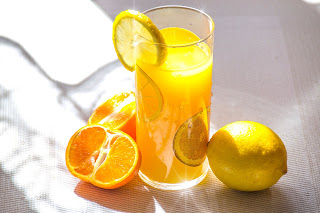How to make orange juice
Dutch still-life painters adored lemons. Seventeenth-century
artists such as Pieter Claesz and Willem Claesz. Heda painted
hundreds of them, luminous renderings using multiple layers
of vivid pigments and glazes. A whole lemon casts an ovoid
of sunlight upon a pewter plate. Gleaming slices of lemon
and cut lemon halves accompany fish, oysters and meat pies.
Giant curls of lemon peel accompany wine-filled goblets,
glasses and gilt cups.
Strikingly, the lemons in these paintings are always prom -
inent, never insignificant. Placed in the foreground, painted
with sensual delicacy and a kind of reverence, they cast a
golden light close to the viewer, as if to seduce the gaze.
Today the lemon might seem ordinary, but in seven-
teenth-century Europe it was anything but. Starting in the
late eleventh century, Crusaders had brought back citrus
and other desirable goods from the East and in much of
Europe lemons remained both costly and coveted for cen-
turies. At a Westminster Hall banquet given for Henry
and Anne Boleyn in , among the luxuries gracing the
table was a single lemon, which had cost six silver pennies.
Even in , when a dozen ‘unwasht’ lemons could be pur-
chased in a London market for three shillings, they were far
exotic spices or lemons, he could still in a sense lay claim tothese objects by displaying a still-life painting of them in hishome. Tens of thousands of seventeenth-century still-lifesfulfilled just such desires.Those who could afford lemons found spirited pleasurein the zest, a flavour so uplifting that in medieval times physi-cians prescribed it as an antidote for melancholy (the word‘zest’ retains this association with lively enjoyment). The Dutchand Flemish often flavoured wine and spirits with lemon zest,much like today’s citrus-flavoured vodkas and gins. Their still-life paintings captured this trend too, placing lemons nearwine-filled goblets or glasses. Typically, the lemon is peeledto midpoint in a continuous ribbon still attached to the fruit,and often a twist of peel curls down the tablecloth, a coil ofgolden light.Lemons also featured in the seventeenth-century fash-ion for edible decoration. ‘Jagged lemons’, round, notchedslices of unpeeled fruit, garnished a whole fish, lobster orcrab, a joint of mutton or a roast pigeon, quail or lark. Round‘lemmon’ slices and lemon halves pricked with rosemarybranches accessorized a ‘grand salad’, alternating withquartered roasted eggs around the plate’s rim. A French cook-book of suggested lemon salad, an arrangement ofthinly sliced peeled lemons topped with sugar, orange andpomegranate blossoms. Pickled lemon peel brightened wintersalads, such as ‘A Sallet of Lemmon, Caveer [caviar], Ancho -vies, and other of that nature’, advised by William Rabisha inThe Whole Body of Cookery Dissected, published in London in, ‘to corroborate the palate, and cause appetite’.The idea of a sweet ‘after-course’, considered an antidoteto the banquet’s overindulgence, was as yet confined to thewealthy. Expensive imported sugar, long associated withlemon, was still out of reach for ordinary people, and thus
exotic spices or lemons, he could still in a sense lay claim to
these objects by displaying a still-life painting of them in his
home. Tens of thousands of seventeenth-century still-lifes
fulfilled just such desires.
Those who could afford lemons found spirited pleasure
in the zest, a flavour so uplifting that in medieval times physi-
cians prescribed it as an antidote for melancholy (the word
‘zest’ retains this association with lively enjoyment). The Dutch
and Flemish often flavoured wine and spirits with lemon zest,
much like today’s citrus-flavoured vodkas and gins. Their still-
life paintings captured this trend too, placing lemons near
wine-filled goblets or glasses. Typically, the lemon is peeled
to midpoint in a continuous ribbon still attached to the fruit,
and often a twist of peel curls down the tablecloth, a coil of
golden light.
Lemons also featured in the seventeenth-century fash-
ion for edible decoration. ‘Jagged lemons’, round, notched
slices of unpeeled fruit, garnished a whole fish, lobster or
crab, a joint of mutton or a roast pigeon, quail or lark. Round
‘lemmon’ slices and lemon halves pricked with rosemary
branches accessorized a ‘grand salad’, alternating with
quartered roasted eggs around the plate’s rim. A French cook-
book of suggested lemon salad, an arrangement of
thinly sliced peeled lemons topped with sugar, orange and
pomegranate blossoms. Pickled lemon peel brightened winter
salads, such as ‘A Sallet of Lemmon, Caveer [caviar], Ancho -
vies, and other of that nature’, advised by William Rabisha in
The Whole Body of Cookery Dissected, published in London in
, ‘to corroborate the palate, and cause appetite’.
The idea of a sweet ‘after-course’, considered an antidote
to the banquet’s overindulgence, was as yet confined to the
wealthy. Expensive imported sugar, long associated with
lemon, was still out of reach for ordinary people, and thus



Blogger Comment
Facebook Comment